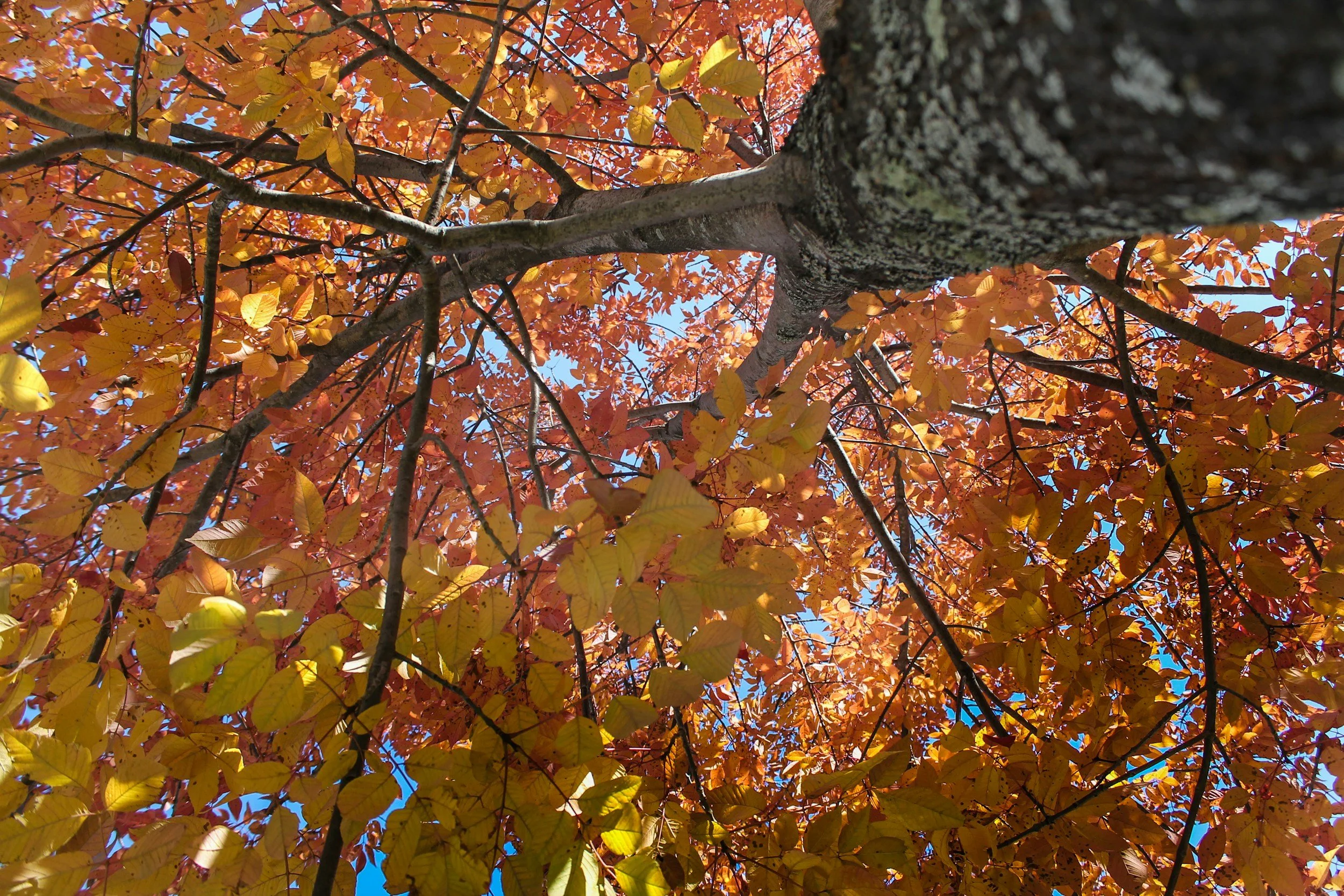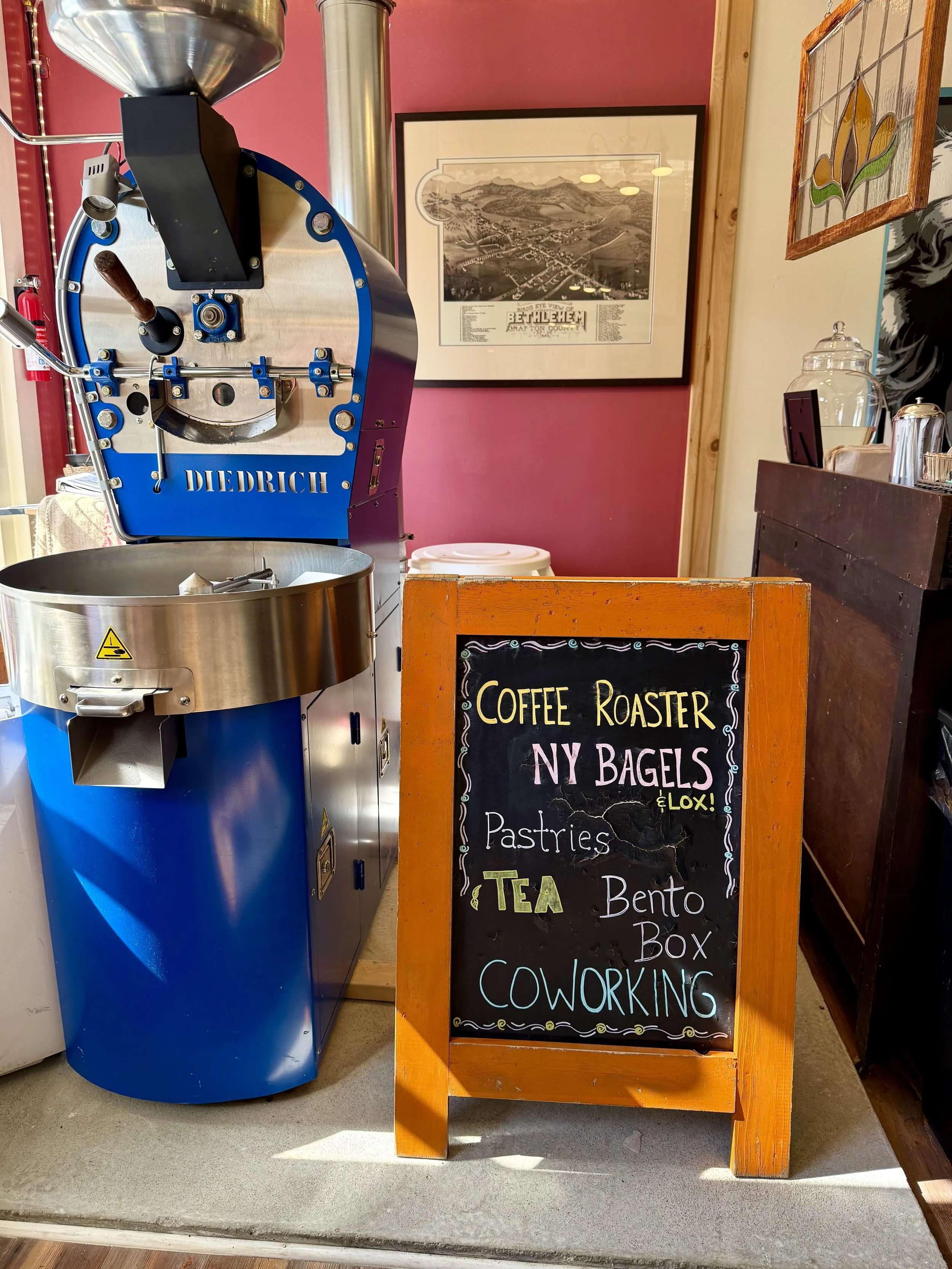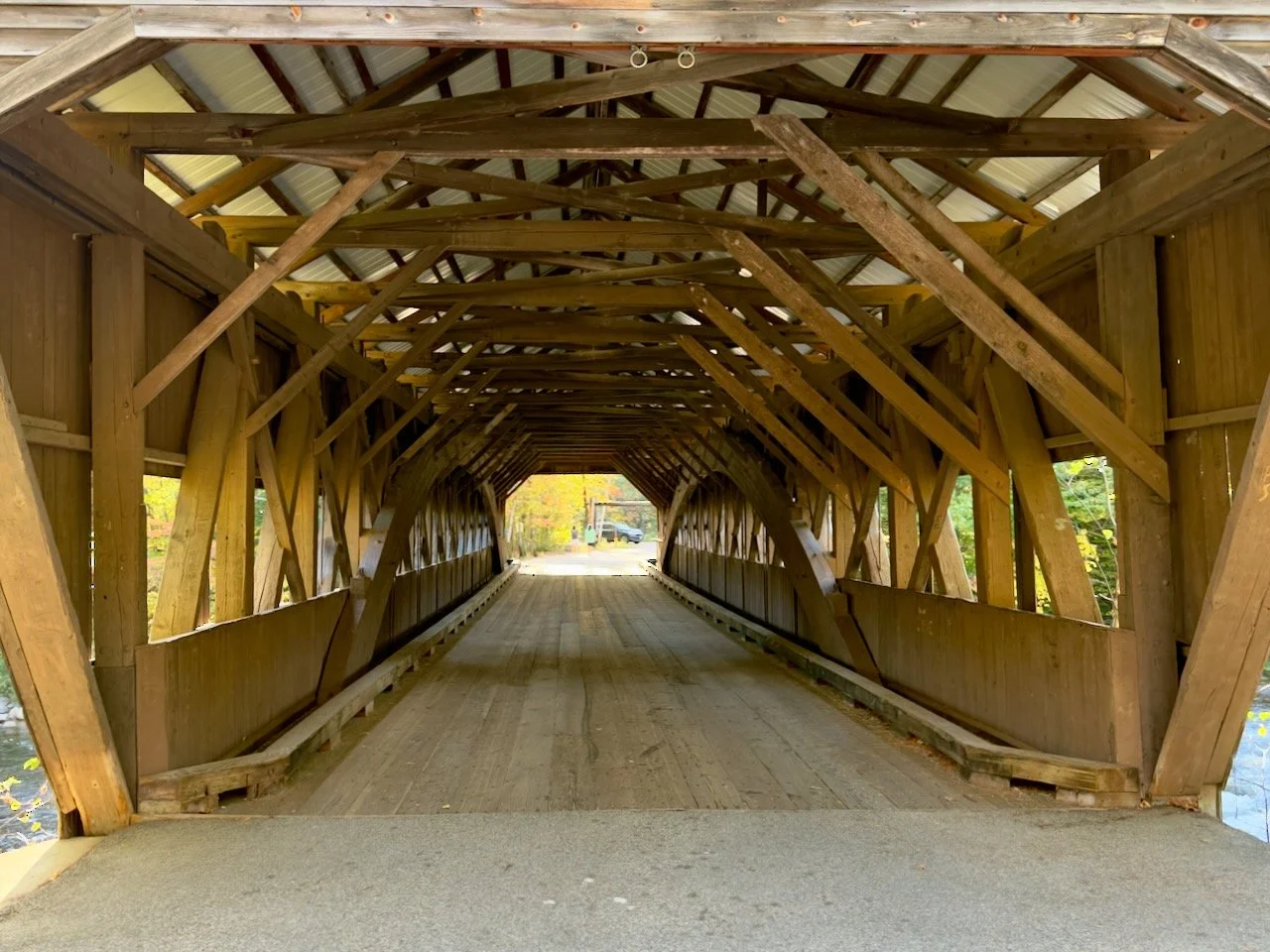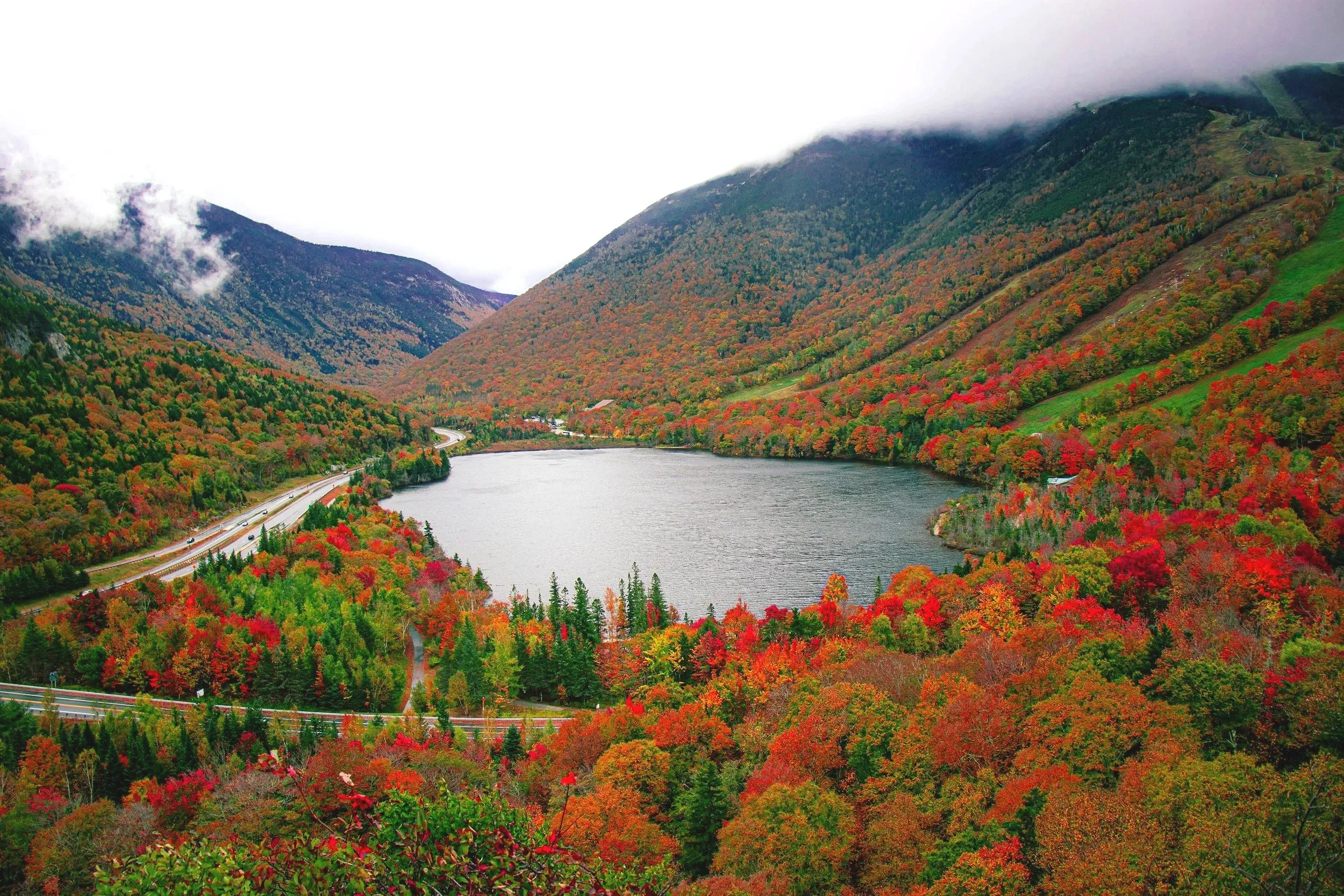My Photography & Travel Guide to the White Mountains, New Hampshire
Introduction: Why the White Mountains Are a Photographer’s Dream
There's absolutely nothing better than spending a week in New England chasing the changing colors of Fall. After visiting Acadia (click on the link to read about Acadia), our next stop was the White Mountains of New Hampshire.
The thing that struck me most was the intense smell of pine needles. It smelled like Christmas. Then you look up and see the incredible fall colors. I have never seen such dramatic fall colors as in New Hampshire.
While it can be challenging to determine precisely when Fall Foliage will reach its peak, a good guess is between September 25 and October 10. But even if the leaves are at 80 or 90% of peak, it is amazing. Here is a link to a good resource for tracking fall foliage. I always check 2 different links for Fall Foliage Maps. The second link for tracking fall foliage is here. These mountains aren’t towering like the Rockies, but they have a quiet grandeur — layered ridgelines, tumbling waterfalls, and villages with church steeples that look hand-painted against the sky.
For photographers, the White Mountains are a playground. Every season offers something new: spring waterfalls swollen with snowmelt, summer wildflowers in alpine meadows, fiery fall foliage, and snow-draped covered bridges in winter. The light here is fast and moody — fog settles into valleys at dawn, then clears by mid-morning, only to return with sunset. It rewards those who rise early, wander, and wait.
Crawford Notch
In this Photography Guide to the White Mountains, I’ll share my favorite photo spots — from Albany Covered Bridge and Lily Pond to Artist’s Bluff, Crawford Notch, and Sugar Hill Overlook. You’ll also find tips for iPhone photography, where to stay, a relaxed 4–5 day itinerary, seasonal advice, and my go-to cafés (including the wonderfully cozy cafe called That Place Above the Notch in Bethlehem).
🏨 Where to Stay in the White Mountains
Choosing the right base in the Whites isn’t just about convenience — it’s about stepping into a mood that shapes your photographs.
North Conway buzzes with energy. It’s the most walkable of the mountain towns, lined with boutiques, cafés, and easy access to the Kancamagus Highway. Stay here if you like having restaurants at your doorstep and golden-hour views from Cathedral Ledge just minutes away.
Lincoln feels quieter, tucked closer to Franconia Notch. It’s the perfect base for sunrise hikes to Artist’s Bluff, reflective mornings at Lily Pond, and sunsets at Sugar Hill Overlook.
Jackson is the romantic choice. Think covered bridges, cozy inns, and easy access to Crawford Notch. In winter, the town transforms into a snow globe scene that photographers can’t resist.
The Omni Mount Washington
Luxury Picks
Omni Mount Washington Resort – A historic grand hotel with sweeping views of Mount Washington. Its wraparound verandas are made for sunrise shots, and its Gilded Age interiors feel cinematic. We had a nice room with great views. The only downside is that the food in the hotel is not so good.
The Wentworth – An elegant inn in Jackson, where whitewashed porches and manicured gardens look plucked from a postcard. Step outside and you’re minutes from the Honeymoon Covered Bridge.
Adventure Suites – A playful wild card in North Conway, with themed suites (from Roman villas to log cabins). The whimsical interiors make it as photogenic indoors as the landscapes outside.
Mid-Range & Boutique
RiverWalk Resort at Loon Mountain – Modern, spacious suites with kitchenettes — ideal for extended stays in Lincoln. Balconies overlook the mountains, perfect for golden-hour editing sessions.
The Inn at Thorn Hill & Spa – A romantic Jackson hideaway with fireplaces, a full spa, and candlelit dining. After a day shooting waterfalls, this is where you want to recharge.
Stonehurst Manor – A North Conway classic, with wood-paneled libraries, mountain views, and a cozy, old-world atmosphere that feels like stepping into a New England novel.
Reflections at Sunrise
📅 Ideal Duration of Stay & Itinerary
A 4–5 day trip is perfect for photography without feeling rushed. But you could easily see most of the spots in 2-3 days as well.
Day 1: Arrive in North Conway. Late afternoon at the train line near the White Mountains Visitor Information Center for classic train + mountain compositions. Sunset at Cathedral Ledge. Dinner at Moat Mountain Smokehouse.
Day 2 (Kancamagus Highway Focus): Sunrise at Lily Pond. Continue along the Kanc with stops at Albany Covered Bridge, Rocky Gorge, Otter Rocks, and Sabbaday Falls. Midday, photograph the suspension bridge at Lincoln Woods Trailhead. Sunset at Artist’s Bluff.
Day 3: Explore Franconia Notch: Flume Gorge, Cannon Tramway, Echo Lake. Sunset at Sugar Hill Overlook.Dinner at Black Mtn. Burger Co.
Day 4: Into Crawford Notch for waterfalls, rail lines, and valley vistas. Stop at CL Graham Wangan Grounds Overlook for layered ridgelines. Sunset from Bretton Woods toward Mount Washington. Dinner at White Mountain Cider Co.
Day 5: Breakfast at Banner’s Restaurant (Conway) or coffee at That Place Above the Notch (Bethlehem). Review shots and head home.
📱 Pro Tip: Use your phone for spontaneous reflections and street scenes; reserve the DSLR for waterfalls, golden-hour ridgelines, and long exposures.
Best Time to Visit
Spring (Apr–May): Snowmelt rivers — great for Sabbaday Falls, Rocky Gorge, Otter Rocks.
Summer (Jun–Aug): Long days, alpine flowers, moody storms — Sugar Hill Overlook shines.
Fall (late Sep–mid Oct): Peak foliage, foggy mornings — don’t miss Lily Pond, Artist’s Bluff, CL Graham Wangan Grounds.
Winter (Dec–Feb): Snowy bridges + frozen falls — Albany Covered Bridge and the Conway train line feel postcard-perfect.
📷 My favorite? Early October. Mist at dawn in Crawford Notch and fiery reds along the Kancamagus Highway.
But to be honest, if there’s one season that defines the White Mountains, it’s fall…
Drone from my DJI
🍁 Why Fall Foliage in the White Mountains Is Incredibly Beautiful
From late September through mid-October, the hillsides become a mosaic of red maples, golden birches, and amber oaks. The drama here is the setting: layered ridges, river mirrors, and valley fog that burns off into crystalline afternoons.
For photographers, fall is pure gold — softer light, clearer air, and color contrast against granite. The Kancamagus Highway delivers the big vistas; the quiet magic happens at Lily Pond at sunrise, Albany Covered Bridge in fiery frame, and the wide-open drama of Crawford Notch at dusk.
📱 iPhone Tip: Use HDR in bright midday foliage to balance punchy highlights and deep shadows.
📷 Pro Camera Tip: A polarizer cuts glare on shiny leaves and water, supercharging reds and oranges.
Fall is fleeting — sometimes just two perfect weeks — which is exactly why these photos feel once-in-a-lifetime.
The Views during Early Morning Drive
🌲 Jim Salge’s Insider Photography Tips
If I had to trust one voice on foliage and light, it’s Jim Salge — local photographer and former meteorologist. His seasonal notes are super helpful.
Fog & Frost: Calm, cool nights after warm days set up valley fog (think Crawford Notch, Lily Pond). First frost deepens color.
Overcast Wins for Waterfalls: Sabbaday and Rocky Gorge pop under soft, cloudy light.
Edges of the Season: Early swamp maples (late Sep) and late golden tamaracks (mid–late Oct) keep the color story going.
Quieter Places: Cherry Pond (Jefferson) & Pondicherry Wildlife Refuge for reflections, wildlife, and calm.
Ethics: Stay on trails (especially at Artist’s Bluff), and give moose room.
📌 Pro Recommendation: Planning a foliage trip? Follow Jim’s seasonal forecasts in Yankee Magazine.
🚇 Getting Around
This is a road-trip landscape. You will definitely need a car.
Kancamagus Highway: Albany Covered Bridge, Rocky Gorge, Sabbaday Falls, CL Graham Wangan Grounds.
Franconia Parkway: Artist’s Bluff, Echo Lake, Sugar Hill Overlook.
Crawford Notch Road: Waterfalls, rail lines, sweeping valleys.
Closest Airports
Burlington, VA (BVP) is 2.5 hours away.
Manchester (MHT) is 2.5 hours away
Boston Logan Airport is 2 hours away
Pro Tip: Cell Service is nonexistent in the White Mountains, so definitely download Google Maps to your cell phone.
Look Up
Dining & Coffee in the White Mountains
In the White Mountains, meals aren’t just fuel — they’re part of the story. A steaming cup of coffee before sunrise, a diner breakfast where locals trade trail reports, or a fireside dinner after chasing waterfalls all become part of your travel rhythm.
That Place Above the Notch - love this place
These are my favorite spots where the food and the atmosphere are equally photogenic.
Banner’s Restaurant (Conway) – A true local’s diner with steaming coffee mugs and hearty plates. The morning light through its wide windows is perfect for editing yesterday’s shots over pancakes.
That Place Above the Notch (Bethlehem) – More than just a coffee shop, this is a creative hub. Natural light spills across rustic tables, making it a wonderful place to work through images while sipping a hand-poured brew. This was our favorite spot.
Moat Mountain Smokehouse (North Conway) – A rustic brewpub with exposed beams, oversized pints, and plates that beg to be photographed. It’s the perfect après-hike spot when your camera roll is full of waterfalls.
Polly’s Pancake Parlor (Sugar Hill) – An institution. The maple syrup pours against a mountain backdrop are as photogenic as they are delicious. Get a window seat if you can — the morning light here is unbeatable.
Black Mtn. Burger Co. (Lincoln) – A casual, cozy spot to warm up after a cold sunset shoot. Burgers are hearty, but the local craft beer lineup deserves attention too.
White Mountain Cider Co. (Glen) – Where rustic chic meets refined plates. Candlelit dinners here feel cinematic — try to book near golden hour so the last of the mountain light filters in.
Frontside Coffee Roasters (North Conway) – A bright, airy café with clean design and a wall of windows. It’s the kind of space where your flat white looks as good in photos as it tastes.
The Sunrise Shack (Glen) – A grab-and-go favorite for photographers heading out before dawn. Quick bites, strong coffee, and a roadside vibe that sets the tone for a morning on the Kancamagus.
The Colors are so vivid
📷 Photography Gear to Bring
DSLR/Mirrorless:
Canon R5 Mark 2 (or equivalent Sony, Nikon)
16–35mm (landscapes/waterfalls)
24–70mm (general/towns)
70–200mm or 100–500mm (mountain compression)
Tripod (waterfalls/night) • ND filters • Polarizer
iPhone/Smartphone:
Portrait Mode • Night Mode • Pano • Live → Long Exposure for waterfalls • Lightroom Mobile/Snapseed • Battery pack
Those Colors are Unreal
Pro Gear Tip: Use a Polarizer in Fall
Why it matters:
A circular polarizer is the one filter that can completely transform your fall foliage shots in the White Mountains.
✨ Richer Colors – Cuts glare off shiny leaves, so reds and oranges pop with intensity.
☁️ Dramatic Skies – Deepens blue skies and makes clouds stand out with more texture.
💧 Reflection Control – Perfect for Lily Pond, Otter Rocks, Albany Covered Bridge. Dial in reflections or reveal what’s beneath the surface.
🌫️ Clearer Contrast – Cuts haze in Crawford Notch on misty mornings.
📱 Smartphone Hack: Try a clip-on polarizer for iPhones/Androids. They’re small, affordable, and surprisingly effective.
⚡ Pro Tip: Polarizers work best when you’re shooting at a 90° angle to the sun. Rotate the filter slowly — you’ll see the scene transform live.
On the Kanc by Rocky Gorge
Drone Photography in the White Mountains
Drones are allowed in White Mountain National Forest, but you must be ¼ mile from highways, picnic areas, and trailheads — tricky because many icons sit right off the road (Albany Covered Bridge, Rocky Gorge, Sabbaday, Artist’s Bluff).
✅ Best chances: Hike-in, remote forest roads.
❌ Not ideal: Kanc roadside stops (too close to the highway).
📏 Follow FAA rules: <400 ft, line of sight, avoid crowds.
📱 Bring a battery pack if your phone is the controller.
Pro Insight: Legal in theory, but often better left on the ground here — dense trees, gusty winds, and the ¼-mile rule limit results.
Drone Shots can really produce amazing images
My Favorite Photography Spots
You will want to focus on the Kancamangas Highway (pronounced Kanc-ah-mah-gus and also known as ‘the Kanc’), a 34-mile / 55 km scenic road in the White Mountains, New Hampshire. The route starts/ends in Lincoln and Conway. You can drive the route in either direction.
The road is named after Chief Kancamagus, who was the last sagamore (chief) of the Pennacook Native Americans and was known as the “Fearless One.” The highway originally started as two separate, unconnected roads, one from Lincoln and one from Conway, but starting in the 1930s, the Civilian Conservation Corps (CCC) worked to connect them, which took 25 years.
You can start the Kancamagus Highway in either Lincoln or Conway, New Hampshire, both of which are small towns surrounded by the White Mountains in the north-central part of the state.
Source: WMAA
Here are some of my favorite locations:
1. Albany Covered Bridge
Why this spot: A classic covered bridge you can drive or walk across with beautiful surroundings. The photo that ends up on postcards — but better when it’s your own. A classic red bridge framed by the Swift River.
Details: Easy roadside access with parking nearby. If you start the Kanc fro Conway this will be your first stop.
📷 DSLR Tip: Use a wide-angle (16–35mm) and a polarizer to cut glare off the water. Long exposures work beautifully here.
📱 iPhone Tip: Shoot low and close to the river rocks for a dramatic foreground.
2. Lower Falls
Why this spot: The roar of water rushing through granite walls gives you both power and texture. I just loved the fall foliage in the background.
Details: Short walk from a pull-off along the Kancamagus. Very accessible.
Lower Falls
3. Rocky Gorge
Why this spot: Photographers should visit Rocky Gorge in New Hampshire for its dramatic waterfalls, crystal-clear pools, and the chance to capture vibrant reflections framed by rugged granite and seasonal foliage. You can wander down onto the rocks or continue on, across the bridge, and see Falls Pond on the other side.
Details: Short walk from a pull-off along the Kancamagus. Very accessible.
📷 DSLR Tip: Try a 3–5 second exposure with an ND filter for silky water.
📱 iPhone Tip: Use “Live → Long Exposure” mode for instant waterfall blur.
From the Bridge
4. Otter Rocks (Hidden Gem)
Why this spot: A quiet pull-off where still water mirrors foliage like a painting.
Details: Roadside, no hike required. Best at golden hour for reflections.
📷 DSLR Tip: Focus on symmetry — tripod at water level for perfect reflections.
📱 iPhone Tip: Use panorama mode horizontally to capture both water and forest canopy.
These hidden gems are magical with no people around
5. Sabbaday Falls
Why this spot: A three-tiered waterfall tucked into shaded woods — feels timeless, like a secret world.
Details: Easy 0.7-mile round trip hike on a gravel trail with wooden railings.
📷 DSLR Tip: Overcast days are your friend here — perfect even light for long exposures.
📱 iPhone Tip: Get close to the railing and use portrait mode to add depth with the railings framing the falls.
Loved the Leaves on the Rocks Photo Credit: Zena
6. Lily Pond (Hidden Gem)
Why this spot: A dawn reflection spot — on calm mornings, the pond is a mirror to the sky.
Details: Roadside pond with parking across the road. Go at sunrise for still water.
📷 DSLR Tip: Use a polarizer to toggle reflections on/off; dramatic foreground shots with lily pads add depth.
📱 iPhone Tip: Tap to lock focus on the reflection, then drag down exposure slightly to deepen color.
Reflections
7. Lincoln Woods Trailhead
Why this spot: A suspension bridge over the Pemigewasset — both a subject and a gateway to wilderness.
Details: Easy 5–10 minute walk to the bridge; longer hikes possible beyond.
📷 DSLR Tip: Use leading lines of the bridge to pull the eye toward the forest.
📱 iPhone Tip: Stand centered on the bridge for symmetry — pano mode vertically works great here.
Fall Reflections
8. Artist’s Bluff
Why this spot: The shot every foliage chaser dreams of — Echo Lake glowing beneath fiery mountains.
Details: About a 30-minute moderate hike with rocky footing. Start before sunrise to beat the crowds.
📷 DSLR Tip: A mid-zoom lens (24–70mm) lets you compress mountains and lake. Tripod is helpful at dawn.
📱 iPhone Tip: Use wide-angle for dramatic perspective; try crouching for added depth with foreground brush.
Artist Bluff
9. Sugar Hill Overlook
Why this spot: Endless layers of the Franconia Range, glowing at golden hour.
Details: Roadside overlook, no hike required. Stunning at sunset.
📷 DSLR Tip: A telephoto lens (70–200mm) captures compressed ridge layers with mist.
📱 iPhone Tip: Use pano mode slowly to capture the whole sweeping range.
A fantastic overlook
10. CL Graham Wangan Grounds Overlook
Why this spot: Painterly ridges stacked against the horizon — classic White Mountains drama. One of our favorite spots.
Details: Large paved overlook on the Kancamagus Highway; easy access.
📷 DSLR Tip: Best with a telephoto to layer ridgelines. Bring a polarizer to cut haze.
📱 iPhone Tip: Frame with guardrails or signs in the foreground for scale.
Our favorite overlook
11. Train Line near the White Mountains Visitor Information Center
Why this spot: Romance of travel in one frame — steel rails, vintage trains, and mountain backdrops.
Details: Roadside near Conway; time your visit with train schedules for action shots.
📷 DSLR Tip: Use burst mode to catch the train in motion; mid-zoom lens for dynamic framing.
📱 iPhone Tip: Use video to capture steam or motion, then pull stills later.
Lucky Timing catching the train
12. Crawford Notch
Why this spot: Drama at scale — cliffs and valleys that change mood every few minutes.
Details: Multiple pull-offs along Route 302. Easy access with big variety.
📷 DSLR Tip: A wide lens captures the whole valley; wait for fog to lift for drama.
📱 iPhone Tip: Blue-hour shots work great handheld — no tripod needed for silhouettes.
Sunrise
13. Fourth Iron Bridge, Crawford Notch State Park (Hidden Gem)
Why go: Fourth Iron is one of those quiet showstoppers — the kind of place most people drive past without realizing what they’ve missed. The old pedestrian suspension bridge spans the Saco River and frames a jaw-dropping view straight into Crawford Notch. You get rushing water, rustic steel, and mountain peaks fading into mist — all in one frame.
When to go:
Early morning: Best chance for fog along the river and soft side light on the cliffs.
Late afternoon: Warm tones hit the steel bridge and the trees behind it glow.
Fall: The reds and yellows against the bridge’s iron structure are pure New England magic.
Photography Tips:
📷 For DSLR/mirrorless: Use a 24–70mm lens — wide enough for context, tight enough to isolate textures and patterns in the bridge cables. A polarizer helps with reflections on the water. Try long exposures (1–4 seconds) to smooth the Saco’s flow.
14. Driving the Kanc
My advice is to drive around the Kanc. You will be surprised at how many incredible locations you will find.
🎉 Festivals & Events
Fall Foliage Season (Sep–Oct): Roads blaze with color; valley fog creates daily light shows. Why shoot it:Fleeting intensity makes every frame feel urgent.
Return of the Pumpkin People (Jackson, Oct): Life-size pumpkin scenes in town windows and lawns. Why shoot it: Playful storytelling meets golden autumn light.
Mount Washington Hillclimb Auto Race (Jul): Cars thunder up a legendary mountain road. Why shoot it: Motion vs. immovable granite = dynamic frames.
Christmas in the Valley (Dec): Snow, lights, covered bridges; quintessential New England. Why shoot it: Blue-hour holiday scenes feel storybook-real.
Final Thoughts
The White Mountains are one of those rare places that feel bigger than the sum of their parts. One morning you’ll be knee-deep in mist at Lily Pond; that same evening you might watch the sun turn Crawford Notch gold. The magic isn’t just in the landscapes but in how quickly they change — light, weather, and color shifting in ways that keep photographers endlessly inspired.
Whether you’re traveling with a camera or just your iPhone, you’ll chase reflections, fog, and fiery foliage that feel almost unreal. Time it right, and the Whites will hand you photographs — and memories — that stay long after the leaves fall.
If this guide helped you plan your White Mountains photo trip, I’d love it if you could share it or tag me in your shots @chasinghippoz. And if you’re curious about joining one of my future New England photography workshops, subscribe to my newsletter below or follow me on Instagram and Facebook.
The mountains change with every season, but one thing stays the same — they’ll always reward those who chase the light.
















































